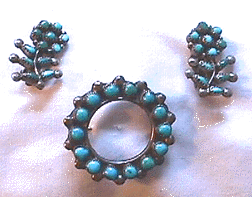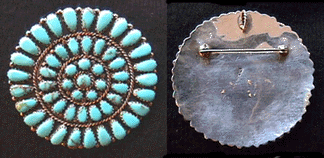
BIDDINGTON'S SILVER and Native American Jewelry Gallery BIDDINGTON'S Index to Content

turquoise
The name derives from the Old French for Turk.

What is it?
Turquoise is a semi-precious gemstone found in desert regions throughout the world.
Who uses it?
All the cultures--Mongolian, Chinese, Native Australian, Persian & Southwestern Native American--who enjoy turquoise veins in their vicinity consider it a source of good fortune and beauty.

Are the brown or grey streaks in my turquoise considered flaws?
These browns and greys are from the matrix, or mother stone, from which the turquoise is mined. Interesting matrix patterns are considered to add beauty to the stone. Only Persian turquoise is usually without apparent matrix. Modern turquoise "stones" that appear very shiny and absolutely flawless are actually manufactured: Pulverized turquoise is reconstituted with a plastic binding medium then cut & shaped as though it were natural stone. Collectors generally avoid this material.
Why are there different colors of turquoise--varying from sky blue to nearly green--in the old Zuni circle pin and earrings?
Natural, untreated turquoise is quite porous. Touching the stone leaves oils on it that--over the years--alter the color of the turquoise. Turquoise can be "treated", i.e. plasticized, so that its color never changes. Collectors tend to favor, and therefore value more highly, natural turquoise with its nuanced color. This feature represents the patina of time.
Is turquoise always set in silver?
Not always. The preferred material for setting turquoise stones varies by culture: In the Mideast, Persian turquoise is traditionally set in gold for women and in silver for men. In the American Southwest, silver working and silver settings were introduced by the invading Spanish explorers; before that period, the turquoise was drilled and strung as beads.
View
BIDDINGTON'S FINE ART & JEWELRY GALLERIES
More PEDIGREE & PROVENANCE:
P&P: Abstract Expressionism
P&P: Arte Povera
P&P: Ash Can School
P&P: bronze patina
P&P: citrine
P&P: Colorfield painting
P&P: Greek columns
P&P: Conceptual Art
P&P: coromandel
P&P: depression glass
P&P: enamel
P&P: encaustic
P&P: etching
P&P: faux
P&P: foreshortening
P&P: gouache
P&P: Iconography & Iconology
P&P: New Image painting
P&P: Newcomb pottery
P&P: parfleche
P&P: Pop Art
P&P: porcelain
P&P: realism
P&P: Senufo
P&P: Surrealism
P&P: turquoise
ABOUT THIS FEATURE
In the art & antiques world, experts bandy about arcane words as though they were part of everyone's standard vocabulary. To a fledgling collector, this practice can be maddening. In PEDIGREE & PROVENANCE, BIDDINGTON'S picks a word or phrase and gives it a good, hard going over: defining it, explaining it and showing how to use it. Glance regularly at PEDIGREE & PROVENANCE, and soon you'll be able to toss those obscure phrases back at the experts with confidence and agility and be fully prepared to purchase works and to bid on items at BIDDINGTON'S upmarket, online art gallery & antiques auctions.
Contact Biddington's
COPYRIGHT: Images and information within www.biddingtons.com are Copyright Biddington's, Inc. 1997-2005--except where superceded by individual copyrights of the artists.
Downloading or printing for online or print reproduction of any materials without specific written permission from Biddington's, Inc. is prohibited.
JAKE BIDDINGTON'S INVESTING--advice on art collecting.
BIDDINGTON'S BENTLEY--travel for the art & antiques connoisseur. CREATIVE PROCESS--artists' studio visits.
ASK Mrs. BIDDINGTON--conservation of art & fine objects. MY ART--Art for kids.
BIDDINGTON'S--Home & Search





